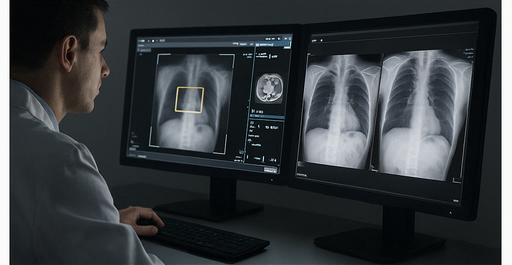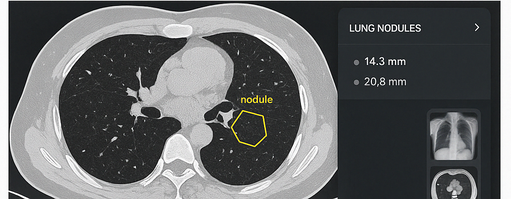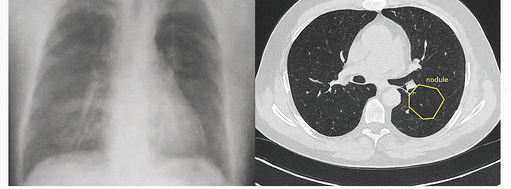Advancements in Radiology
By Neha Singh (Assistant Professor)
The Rise of AI and the Future of Imaging Radiology has always been a cornerstone of modern medicine. From the discovery of X-rays by Wilhelm Röntgen in 1895 to today’s advanced imaging techniques, the field has continued to grow at an exceptional pace. In recent years, the integration of artificial intelligence (AI) has added a transformative layer, revolutionizing how imaging is captured, interpreted, and utilized in patient care. These advancements not only enhance diagnostic accuracy but also improve workflow efficiency and open new avenues for personalized medicine.

Digital Transformation of Radiology One of the most significant shifts in radiology has been the move from film-based systems to fully digital platforms. Digital Radiography (DR) and Computed Radiography (CR), supported by Picture Archiving and Communication Systems (PACS), have made image acquisition faster and more efficient. These digital systems allow easy storage, retrieval, and sharing of images across departments and institutions. Moreover, integration with electronic medical records (EMRs) ensures seamless communication between radiologists and other healthcare providers. The digital ecosystem also enables advanced analytics and serves as a foundation for AI applications in image interpretation and clinical decision-making.

Innovative Imaging Modalities Radiology has seen a surge in the development of advanced imaging modalities that enhance diagnostic capabilities. Dual-Energy CT (DECT) is one such innovation, allowing differentiation of tissues and materials such as calcium, iodine, and uric acid. Hybrid imaging systems like PET/MRI offer the combined advantages of metabolic and anatomical imaging, particularly useful in oncology and neurology. Tomosynthesis, especially in breast imaging, enables three-dimensional views, reducing the effect of tissue overlap and improving early cancer detection. Additionally, high-frequency ultrasound and elastography have expanded capabilities in musculoskeletal and liver imaging, offering insights into tissue stiffness and microvascular changes. Artificial Intelligence in Radiology AI is perhaps the most revolutionary advancement in modern radiology. Deep learning algorithms have shown great promise in detecting abnormalities such as lung nodules on chest CT, brain haemorrhages on non-contrast CT, and tumours in mammography and retinal scans. These systems function as intelligent assistants, flagging potential issues and providing a second layer of review. In terms of workflow, AI helps in triaging urgent cases, automating measurements, and even assisting in structured reporting—thus improving productivity and reducing reporting time. Predictive models are also being developed to analyse imaging, clinical, and genomic data, supporting risk stratification and helping clinicians in personalized treatment planning. This integration of AI not only increases accuracy but also aids in standardizing care across different patient populations.
The Rise of Teleradiology and Remote Collaboration With the widespread adoption of cloud technology, teleradiology has become an essential service, especially in remote or underserved areas. Radiologists can now interpret images from any location, ensuring 24/7 availability of diagnostic services. Cloud-based PACS and secured virtual networks allow rapid sharing of images and reports, which is vital in emergency care. Virtual multidisciplinary team meetings are also becoming more common, allowing real-time collaboration among specialists, which ultimately leads to better clinical decisions. This level of accessibility and collaboration was particularly valuable during global health crises like the COVID-19 pandemic. Challenges and Ethical Considerations While the future of radiology looks bright, the rapid integration of AI and digital systems comes with challenges. One major concern is regulatory oversight—ensuring AI tools meet safety and performance standards before clinical deployment. Data privacy and security are also paramount, as large volumes of patient data are processed and shared. Moreover, bias in AI algorithms trained on limited datasets can lead to inaccurate or non-generalizable results. It’s also essential to understand that AI is not a replacement for radiologists; instead, it should be seen as an enhancement tool. Radiologists will need to adapt, learning how to interpret AI-generated outputs and incorporating them responsibly into clinical practice. What the Future Holds The future of radiology is increasingly data-driven, intelligent, and patient-centred. We can expect real-time AI analysis integrated directly into imaging equipment, providing immediate diagnostic support. The emerging field of radio genomics—which combines imaging features
with genetic information—will offer deeper insights into disease mechanisms and progression.

Augmented reality (AR) and virtual reality (VR) are expected to become valuable tools in radiology education, surgical planning, and even patient counselling. Additionally, as patients gain more access to their health data, radiologists will play a more visible role in communicating findings and guiding clinical care. Conclusion The field of radiology is undergoing a profound transformation, fuelled by advancements in technology and artificial intelligence. These innovations are not only refining how images are captured and interpreted but also reshaping the role of radiologists in the broader healthcare system. As we embrace these changes, radiology will continue to lead the way in delivering faster, more accurate, and personalized care. With AI as a powerful ally, the focus will shift toward smarter, data-informed medicine where radiologists are not just image readers, but key players in clinical decision-making and patient outcomes.
